They Poisoned the World: Life and Death in the Age of Forever Chemicals, by Mariah Blake. New York City: Crown Publishing, 2025; 320 pages, $30.
Fair warning: Whether you have never before heard of per- and polyfluoroalkyl substances (PFAS or “forever chemicals,” as they have become known) or have heard of them and know they’re bad for people but not much detail beyond that, the factual revelations unspooled in this book are likely to create a stew made up of equal parts shock, disgust, and rage at the audacious, craven, longstanding malfeasance and neglect on display.
With They Poisoned the World, author Mariah Blake has, quite simply, compiled a meticulously and exhaustively documented tour de force of investigative journalism. Researched and reported for nearly a decade, the book lays bare an 80-year-long story of corporate malfeasance aided and abetted by regulatory failure that has quite literally put virtually everyone’s health at risk in ways we are only beginning to fully understand.
Further reading:
- An inside look: Resolving the danger surrounding NYC’s Citicorp Tower
- Highly engineered Mississippi River became author’s obsession
- Companies can gain from thinking differently about sustainability, authors say
Blake’s reporting has appeared in outlets ranging from The Atlantic to The New York Times to The New Republic and others. A very early version of her findings that eventually culminated in They Poisoned the World was published in an article in Mother Jones in 2014, prompted originally by her pregnancy and resulting research into how to keep chemicals (particularly bisphenol A) out of her son’s body.
The article documented, among other things, the pervasive degree to which “BPA-free” plastic food containers still leached chemicals with similar negative effects and that the manufacturers of these plastics had sued in an attempt to block publication of a scientific study that reached that conclusion.
Reaction to the article – and Blake’s sense that the story went much deeper – was so strong that she resolved to go as far down the rabbit hole as she could. As it turned out, it took her to two very different kinds of places, both of which are crucial to understanding the full scope of the problem, meaning determining how long it has been going on, how bad the effects can be, and how hard we need to fight to change things.
The first place it took her was all the way back to the Manhattan Project, which ultimately provided the funds and the impetus for DuPont to finally figure out how to produce the newly invented chemical Teflon in large quantities. The promising but not yet commercialized material was ideal because its fluorocarbon bonds made it suitable to stand up to the uranium hexafluoride gas necessary for developing the atomic bomb.
This same time period – and same company – also spawned in the U.S. the so-called Kehoe principle (named after a DuPont-affiliated scientist), which holds that products are to be considered safe until proved otherwise. This principle was the key domino in giving corporations clear incentives to cloud any possible links between their products and adverse health effects in order to avoid regulation.
The second place Blake’s research took her was to a small town in New York named Hoosick Falls, home since the mid-1950s to factories that produced many products using Teflon. In 2016 a local man began questioning why the local cancer rate was so high after several friends and family members died of the disease.
His tenacity over five years of fighting with chemical companies, corrupt officials, law firms acting in bad faith, and in some cases even fellow residents ultimately resulted in a landmark $65 million settlement for the town and its residents.
 Crown Publishing
Crown PublishingWhile the timing of the Hoosick Falls contamination issues coming to light coincided with Blake’s deepening research, she also takes care to point out other similar cases from other towns decades earlier – highlighting the maddening foot-dragging of so many who should have known better, and in many cases did, but refused to speak out or act.
At its core, They Poisoned the World can be read as a hopeful story where, with perseverance, some of the “little guys” ultimately prevailed over some big bad corporations. But it is admittedly difficult to not come away dispirited that it took such effort to get there.
Blake’s engaging writing, including her unflinching but studiously neutral journalistic tone, is a key aspect helping give the book its weight, shorn of distracting melodrama. Perhaps the most heartening aspect is that the story is being told as fully, and as well, as it is here in the hope that it helps continue to shine a light on this specific problem and serve as a cautionary tale that many products ought not be “innocent until proven guilty” when it comes to our health.



